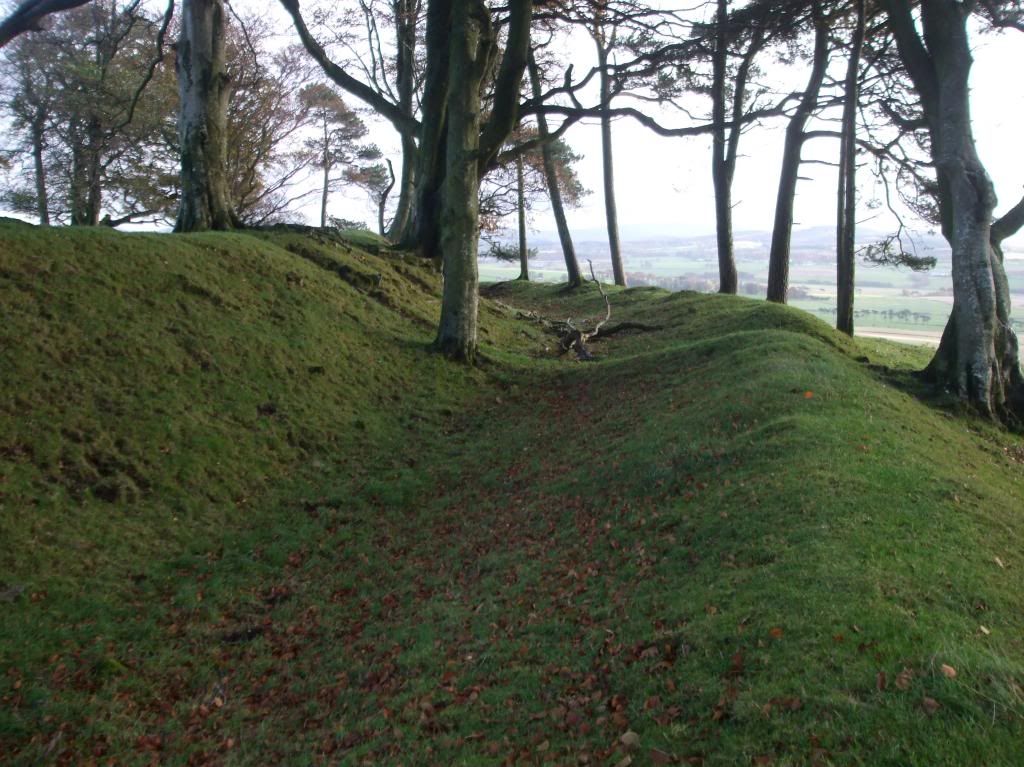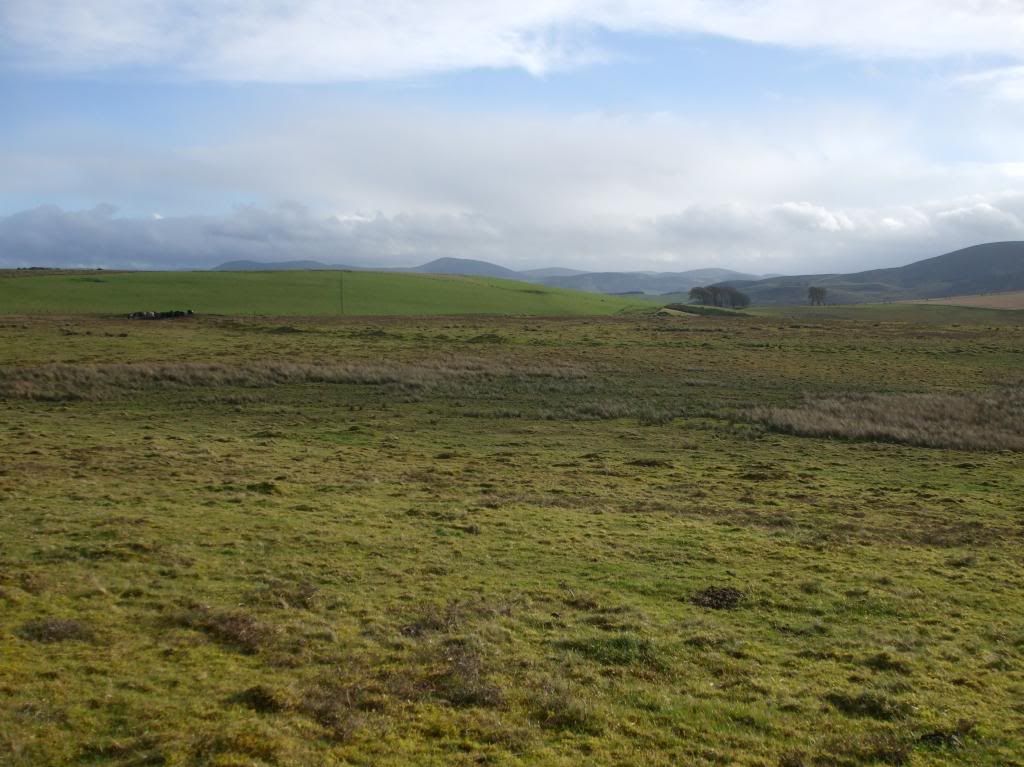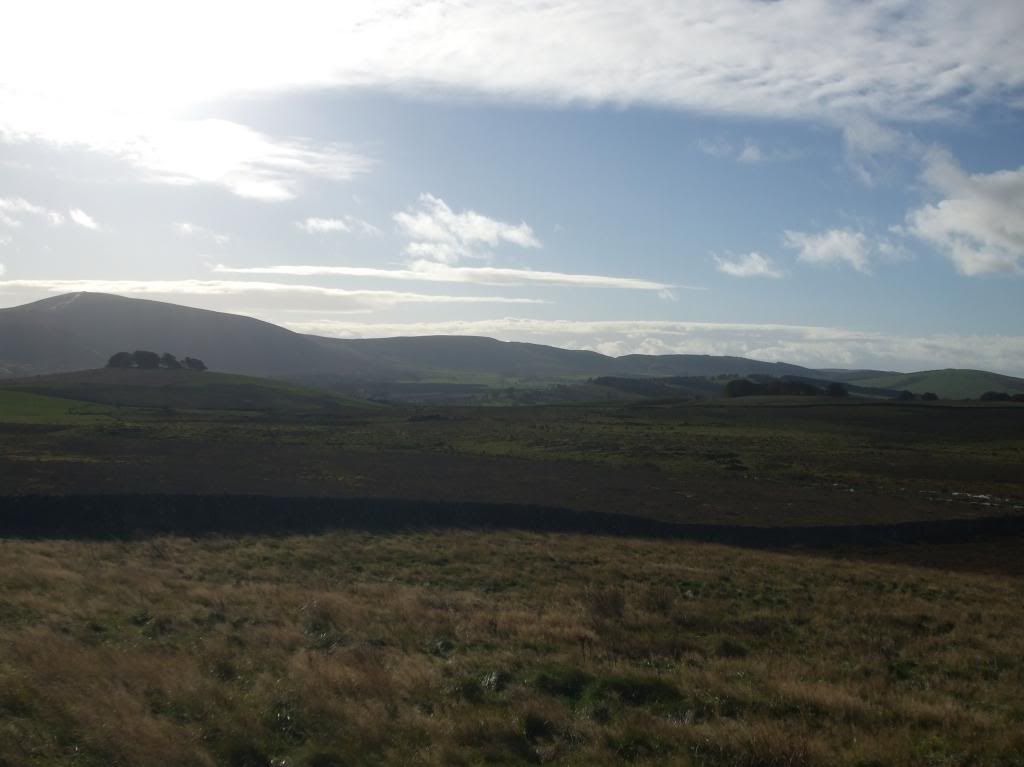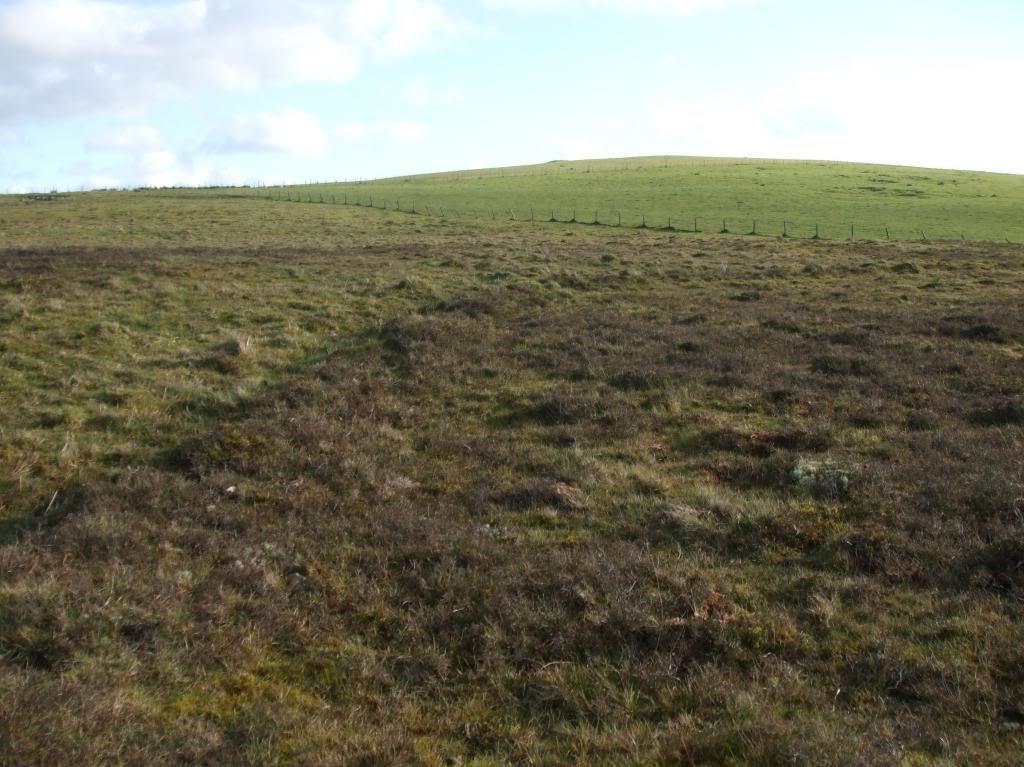Swaites Hill, Or Bust!
Let's have some real archaeology now, shall we? None of this glitzy shiny nonsense that you get in Wessex...
Yes, you've guessed it. Today I went sniffing out monuments in deepest darkest South Lanarkshire. And today I finally got to achieve the ambition of 20 years (alright, 18...) by communing with the Ancestors at the Neolithic ritual enclosure at Swaites Hill.
Yes, prepare to be very underwhelmed!!
Right, I am now going to very madly enthuse about something that will make most of you go, "huh?" While the archaeologists amongst you will nod vigorously, and get very, very excited indeed!!
First stop of the day was the multivallate (i.e. more than one rampart, in this case, two) hillfort at Chester Hill. I took J along with me, and this was his personal favourite, because, as he said, it looked like something.
Actually, I think it looked darned impressive, myself...
In the 19th century, some enterprising landowner decided to turn it into a designed landscape feature. It is approached by a handsome avenue of beech trees:-

At the summit, we find a small circular enclosed area with two very nicely preserved ramparts:-

The location is dramatic, perched on the south end of a ridge of high ground overlooking a flood plain. Unfortunately, this photo doesn't do it justice. Though it does do the ramparts justice. They were very nice indeed....
And now for the main event. The Neolithic ritual enclosure at Swaites Hill.
And here it is:-

I've made this extra big, because you need to be really eagle-eyed to spot it. The trick is to identify the cows at the left hand side of the picture - their feeding area is right on the bank of the monument (tut, tut, Historic Scotland would NOT approve!!! We're talking about a Scheduled Monument here...) Follow a gently sloping line down from the cows to the right hand edge of the picture, just above the centre (vertically) and you'll see a line of shadow. That's the remains of the bank, which is now very spread and pretty much knackered.
Unfortunately, monuments on this scale are just not very photogenic. The thing's humungous, absolutely gigantic. To get a better idea of its scale layout, you can click the Canmore record, which features an absolutely exquisite RCAHMS field survey team drawing:-
http://canmore.rcahms.gov.uk/en/site/47640/details/blackshouse+burn/

The visible remains aren't that impressive to the untrained eye. But the location is stunning. This view looks down across the site of the ritual enclosure, towards the site of the hillfort (see the clump of trees on the right). Looming up in the background is Tinto Hill, which has a BIG kickass Bronze Age funerary cairn on its summit. The ritual enclosure sits in a huge bowl which seems almost like an amphitheatre. The enclosure is right next to a stretch of mossy ground and two springs emerge from its interior. It's very henge-like in some respects - an indication of what Stonehenge would have looked like when it started out as a mere bank and ditch.
It's baffling. And really quite intriguing. The fact that it remained a focus for activity in the period following the Neolithic is proven: Bronze Age cremations have been recovered from the bank, and there are a number of cairns and additional enclosures scattered across the ridge.
Like this example here. Which, once again, takes a bit of a trained eye to identify. It's circular, and I've taken the photo to capture as much of the arc as possible. The line of heather marks the bank, which is about 0.3m high, and stony:-

I think you can also see the silhouette of a cairn on the skyline - that raised bump looks mighty suspicious. They're not all funerary cairns - most are field clearance, dating probably to the Middle Bronze Age. Supposedly, the climate was warmer and drier then, and these marginal lands were cultivable. Things got colder and wetter in the Late Bronze Age, and these upland settlements were abandoned. In many cases round Lanarkshire, agriculture has never been particularly intensive here, hence the excellent levels of preservation.
So it was an exciting and an exhilarating day. I met a raven, and I said a very polite 'hello' to it. I also saw a hare in the middle of the ritual enclosure, which was a strange co-incidence, as I flushed a hare out in similar circumstances at Stonehenge! If hares are symbols of fertility, then I hope it's a good sign - last time, a plot for a novel germinated in my mind.
And yes, I could get a fox hunt up this hill, in case you're wondering.
Now we're having a thunderstorm, so I'm signing off. To quote Clannad, Mysterious rIng, magical ring of stones... Forgotten is the race that no-one knows.
Yes, you've guessed it. Today I went sniffing out monuments in deepest darkest South Lanarkshire. And today I finally got to achieve the ambition of 20 years (alright, 18...) by communing with the Ancestors at the Neolithic ritual enclosure at Swaites Hill.
Yes, prepare to be very underwhelmed!!
Right, I am now going to very madly enthuse about something that will make most of you go, "huh?" While the archaeologists amongst you will nod vigorously, and get very, very excited indeed!!
First stop of the day was the multivallate (i.e. more than one rampart, in this case, two) hillfort at Chester Hill. I took J along with me, and this was his personal favourite, because, as he said, it looked like something.
Actually, I think it looked darned impressive, myself...
In the 19th century, some enterprising landowner decided to turn it into a designed landscape feature. It is approached by a handsome avenue of beech trees:-

At the summit, we find a small circular enclosed area with two very nicely preserved ramparts:-

The location is dramatic, perched on the south end of a ridge of high ground overlooking a flood plain. Unfortunately, this photo doesn't do it justice. Though it does do the ramparts justice. They were very nice indeed....
And now for the main event. The Neolithic ritual enclosure at Swaites Hill.
And here it is:-

I've made this extra big, because you need to be really eagle-eyed to spot it. The trick is to identify the cows at the left hand side of the picture - their feeding area is right on the bank of the monument (tut, tut, Historic Scotland would NOT approve!!! We're talking about a Scheduled Monument here...) Follow a gently sloping line down from the cows to the right hand edge of the picture, just above the centre (vertically) and you'll see a line of shadow. That's the remains of the bank, which is now very spread and pretty much knackered.
Unfortunately, monuments on this scale are just not very photogenic. The thing's humungous, absolutely gigantic. To get a better idea of its scale layout, you can click the Canmore record, which features an absolutely exquisite RCAHMS field survey team drawing:-
http://canmore.rcahms.gov.uk/en/site/47640/details/blackshouse+burn/

The visible remains aren't that impressive to the untrained eye. But the location is stunning. This view looks down across the site of the ritual enclosure, towards the site of the hillfort (see the clump of trees on the right). Looming up in the background is Tinto Hill, which has a BIG kickass Bronze Age funerary cairn on its summit. The ritual enclosure sits in a huge bowl which seems almost like an amphitheatre. The enclosure is right next to a stretch of mossy ground and two springs emerge from its interior. It's very henge-like in some respects - an indication of what Stonehenge would have looked like when it started out as a mere bank and ditch.
It's baffling. And really quite intriguing. The fact that it remained a focus for activity in the period following the Neolithic is proven: Bronze Age cremations have been recovered from the bank, and there are a number of cairns and additional enclosures scattered across the ridge.
Like this example here. Which, once again, takes a bit of a trained eye to identify. It's circular, and I've taken the photo to capture as much of the arc as possible. The line of heather marks the bank, which is about 0.3m high, and stony:-

I think you can also see the silhouette of a cairn on the skyline - that raised bump looks mighty suspicious. They're not all funerary cairns - most are field clearance, dating probably to the Middle Bronze Age. Supposedly, the climate was warmer and drier then, and these marginal lands were cultivable. Things got colder and wetter in the Late Bronze Age, and these upland settlements were abandoned. In many cases round Lanarkshire, agriculture has never been particularly intensive here, hence the excellent levels of preservation.
So it was an exciting and an exhilarating day. I met a raven, and I said a very polite 'hello' to it. I also saw a hare in the middle of the ritual enclosure, which was a strange co-incidence, as I flushed a hare out in similar circumstances at Stonehenge! If hares are symbols of fertility, then I hope it's a good sign - last time, a plot for a novel germinated in my mind.
And yes, I could get a fox hunt up this hill, in case you're wondering.
Now we're having a thunderstorm, so I'm signing off. To quote Clannad, Mysterious rIng, magical ring of stones... Forgotten is the race that no-one knows.